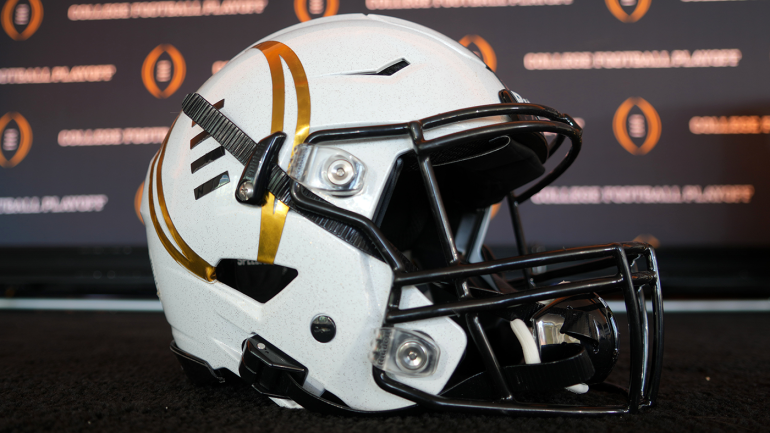
The expanded College Football Playoff is beginning to look like an invitational.
The Big Ten and SEC have grown so powerful and so bold, they are acting like the world is not enough; they'll settle for most of the expanded playoff bracket.
The two giants have united like collegiate Wonder Twins, and their demands are extensive. The conferences, which at one point sought as many as four automatic berths each -- an allowance perhaps never even considered before -- in a further-expanded CFP bracket, now seem to be OK with three each. Well, that's if the Big Ten and SEC are also automatically granted the top two seeds (which would come with byes) in a 14-team iteration of an expanded bracket that would begin in 2026.
"It just means more" has never meant more.
This is about threading a needle through access and money and scheduling and outrage and, well, egos too. There will be plenty of that in the coming days until this latest CFP disturbance is settled. And surely, some will question that teams should need to earn those top two spots by more than their conference affiliation.
Still, a hard truth must be acknowledged: The Big Ten and SEC really do run things. They really do deserve at least some dispensation. That's tough to swallow in a sport like college football, which has occasionally been dominated by swagger and smack talk off the field.
What's difficult is to watch the CFP sausage being made and stuffed through a 14-team bracket.
The 10 FBS commissioners and Notre Dame's administrator, who will continue to meet this month as the CFP Management Committee, are under a hard deadline. ESPN needs to know what it is on the table as it seeks to extend its media rights agreement with the CFP. The conferences need to figure out how they will divvy up the money out of what is expected to be unprecedented, weighted shares while external forces -- revenue sharing, collective bargaining and pay for play -- close in.
At the heart of this discussion is another realization: The CFP doesn't work -- at least not as constructed.
There is clearly a lack of trust in the process helmed by the 13-member CFP Selection Committee whose rankings -- released every Tuesday night from around Halloween onward -- create contrived controversy that generally works itself out ... until it does not.
The results of last season's final CFP Rankings crossed a line for some who watched undefeated Florida State get left out of the top four because its quarterback was injured; this while undefeated Liberty was rewarded with a New Year's Six berth in the Fiesta Bowl despite a schedule strength that didn't compare to that of AAC champion SMU.
Even though it did not impact them in the moment, you better believe the Big Ten and SEC were watching. Neither conference wants to put their fate in the hands of a committee that shifts what it emphasizes from one season to the next, sometimes one week to the next.
What would committee do with, let's say, a 9-3 USC -- that challenged itself against the likes of LSU, Wisconsin, Michigan, UCLA, Notre Dame, Penn State and Washington -- compared to a 10-2 Cincinnati that played Towson, Miami (Ohio), Colorado, Arizona State and TCU?
Should be an easy decision, right? Well, if you leave that decision up to humans, sometimes they make human decisions -- wrong ones.
Hence, the proposed three automatic bids spots for Big Ten and SEC teams and potential for those conferences' champions to be gifted first-round byes.
Would that really be all that bad for the ACC and Big 12? In the 12-team structure set to begin this season, there are only automatic qualifiers (AQs) for the five highest-ranked conference champions. That assumes -- but does not guarantee -- inclusion for those leagues. The newly proposed format would ensure the ACC and Big 12 each get two bids -- every season.
That seems like a flair reflection of the market.
Realignment has led to the Big Ten and SEC compiling the most, best brands -- by a significant margin -- under their roofs. This is one of the results.
The stakes are some of those brands being left out of a national championship chase. Given questions exist about the process (even if they do not rise to the level of flat-out distrust), it should be no surprise that gnawing doubt over subjectivity has led us to this point.
"There's not enough data because you only play 12 games. The data doesn't connect. There is an inherent flaw," one Power Five athletic director told CBS Sports.
"Multiple AQs make a ton of sense because one of the things that is screwed up about college sports is the way we rely on committees. In turn, it causes us to water down our regular season because people try to game their schedule. If you go strictly off of conference standings, I think it makes your regular season better, and you reduce the role of the committee in a positive way."
If a 14-team field without AQs had been in place over the prior 10 years of the CFP, the newly formed Big Ten and SEC would have landed 75% of the top two seeds anyway (15 of 20). That doesn't mean the trend will continue, but it's understandable why AQs are part of the discussion.
Particularly given the football in both major powers is about to get even more difficult. It certainly does not become easier to win games -- let alone a conference -- when Texas and Oklahoma or USC, UCLA, Oregon and Washington join. The SEC remains likely to go to nine conference games at some point. ESPN certainly won't protest if there were 10 SEC league games, nor would CBS, Fox and NBC for the Big Ten.
The difficult part? How to land this new reality in the mind of the American sporting public. A 12-1 team in the Big Ten or SEC -- in general -- won't mean the same as a 12-1 team in other leagues, but how do you say that out loud?
What's being intimated is that this reality should be reflected in AQs instead of human subjectivity.
For now, discussions are preliminary ... until they are not. This is all about to get specific, quickly.
As to the notion that the Big Ten and SEC are considering a departure from the NCAA -- hand in hand -- if things don't go their way?
"I know they're having the discussions," another Power Five AD told CBS Sports. "I know they're engineering. I think they're getting prepared [to make a move] if it gets real radical. One of the questions: Is it in response to a failed CFP process?"
The answer is "yes," and it and cuts to the heart of these discussions.
The CFP is one of the least-transparent championship processes in sports. We never get to see how the committee makes up its mind. AP Top 25 voters are allowed to reveal their rankings each week; voters in the Coaches Poll share their final ballots. Meanwhile, there has always been a "trust us" element to the CFP.
The Big Ten and SEC would rather lean on achievement -- translation: schedule strength -- than an interpretation of 13 well-meaning people in a room. A group of Power Five ADs saw that day coming and started scheduling accordingly.
Take a look at Florida's schedule this year. UCLA will travel the near-equivalent of around the globe to play a similar schedule.
It makes sense. It's also going to be contentious. They could sell tickets to the next CFP meeting (and maybe protective eyewear, too). The battle has just begun. Wait until they actually start playing football in the expanded invitational, er, playoff.





















